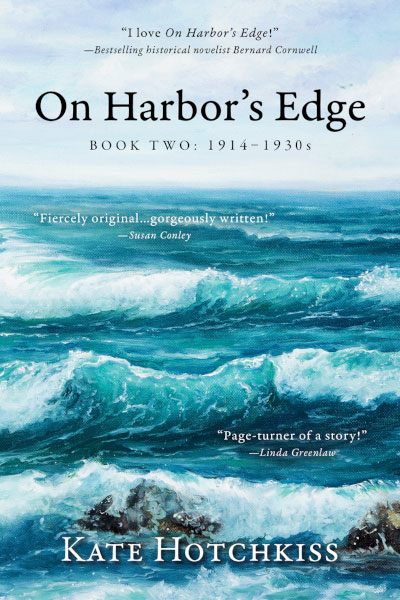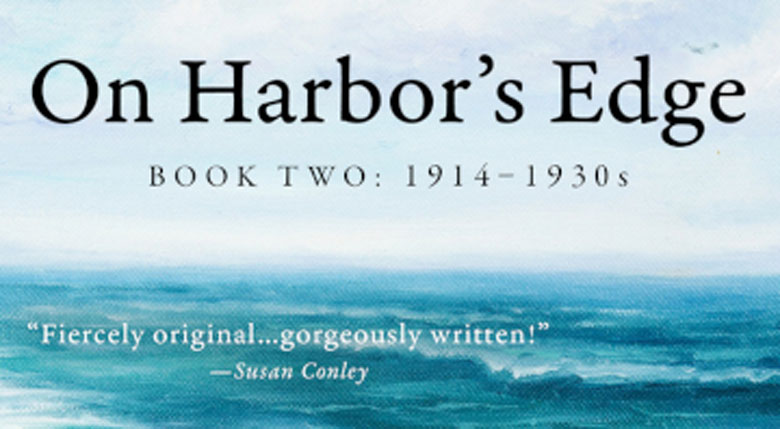On Harbor’s Edge, Book Two: 1914-1930s
By Kate Hotchkiss (Maine Authors Publishing, 2025)
On Harbor’s Edge, Book Two: 1914-1930s—a sequel to Kate Hotchkiss’ On Harbor’s Edge, Book One: 1912-1913—continues the story of Mildred May Gale, husband Thaddeus, their four children, and friends and relations in fictitious Hale Harbor on an island in Maine.
The book opens in August 1918 as news is delivered that the islander who joined American soldiers fighting in World War I in Europe is missing in action. Also, word comes of a pandemic spreading, referred to as “the Spanish flu.”
Relieved to feel safer by being on an island, the family plans to sustain itself while isolating, in part by relying more on seafood.
For those in the village of Hale Harbor, staying healthy also means avoiding travel, preventing the arrival of visitors, and wearing face coverings. Those exposed to the virus or with symptoms isolate in a barn converted for that purpose. The residents are serious about avoiding any contact.
It reminded me of how, during the 2020 COVID outbreak, the town administrator on North Haven—Hotchkiss’ home—proclaimed the island off-limits to visitors, including those with seasonal homes. This was eventually revised.
Mildred finds she enjoys listening as the women talk, seeing their conversation as knitting them together while their actual knitting created nets…
COVID did find its way to Maine islands; residents themselves were traveling back and forth to the mainland and could have been the very ones to carry the virus.
In this volume, Mildred, one of the most anxious residents and an outspoken proponent urging great caution, makes a trip to the mainland, for reasons important enough to her to accept some risk.
Hotchkiss throws a lot together as the story nears its conclusion, loose ends that no doubt will reappear in a sequel, including the state of Mildred and Thaddeus’s marriage, her sister-in-law’s adoption of five orphaned children, the return of the missing soldier, and women’s efforts for the right to vote and equal opportunities in jobs and pay. (I imagine that family planning was not seen as important at that time, at least to women of Popplestone, intent as they were on boosting the number of island children and likely hoping to offset infant and child mortality.)

While Hotchkiss tells this story from a female perspective (as if based on journal entries by Mildred), men share many of the same concerns. They, too, are responsible citizens who care about community life.
But what we are most aware of from Mildred’s interactions is the depth of women’s sharing. Advice is offered; experience is passed along. Sometimes it isn’t verbal, but simply an extra pair of hands to help.
When Mildred visited a different, unfamiliar village on Popplestone, she discovers a group of women gathered in chairs set in a circle outside. Mildred is invited to join and finds she enjoys listening as the women talk, seeing their conversation as knitting them together while their actual knitting created nets for deep sea fishing.
The supportive and friendly mood touched her, as if therapeutic.
She was reminded of how much of her island she has overlooked, and recalled Thaddeus speaking poorly of those residents, calling them “stuck up creatures,” and disagrees with that characterization. Thaddeus had given them short-shrift, and for what reason, she doesn’t know. Now she feels she has new friends.
Isolation on an island is a funny thing. During a pandemic, it might provide a sense of relative safety. Yet ideally, islanders recognize how much they have in common, and work together to the benefit of all.
Tina Cohen is a Massachusetts-based therapist who spends part of the year on Vinalhaven.





